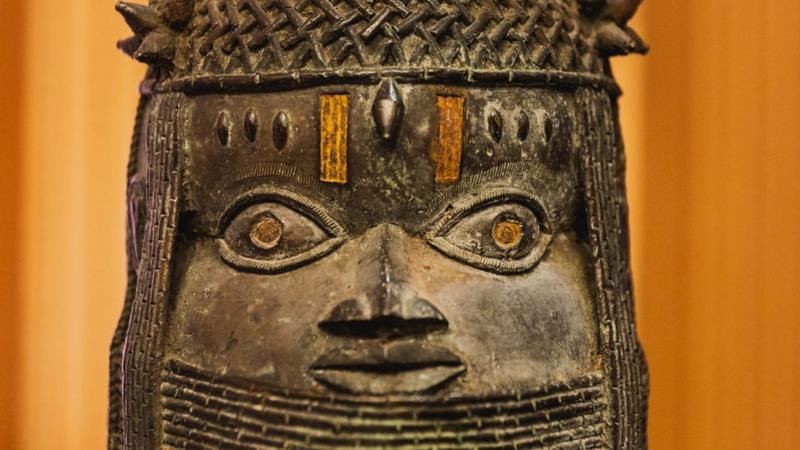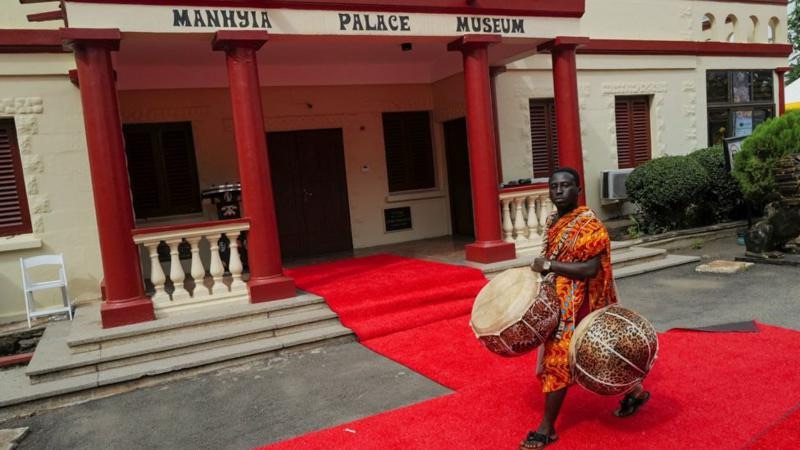Artifacts taken by the British during the colonial era have been returned to Ghana and are now on display. However, Nigeria has yet to exhibit its own repatriated treasures. On April 12, a convoy traveled from Ghana’s capital, Accra, to Kumasi, carrying precious cargo—32 pieces of gold and silver artifacts, including elaborate necklaces, a peace pipe, and a ceremonial sword.
These treasures, plundered by British forces during invasions of Asante land in 1874 and 1896, had resided in the UK until their recent return. The convoy, escorted by police with sirens and flashing lights, made a swift journey to the Manhyia Palace, the residence of the current Asantehene, Otumfuo Osei Tutu II.
The arrival of the artifacts was a momentous occasion, marked by profound emotions as the crates were opened by the king himself. The Asante community, having long demanded the return of these items, celebrated their retrieval. “We did it,” proclaimed Osei Tutu II, encapsulating the triumph of their longstanding efforts.
On May 1, as the gold artifacts were displayed publicly in the Manhyia Palace Museum, the monarch remarked, “These items that were stolen, looted… not all of them have come back. But those we have here still embody the soul of Asante.” Ivor Agyeman-Duah, an author and former diplomat who now serves as the director of the Manhyia Palace Museum, was part of the convoy transporting the artifacts, vigilant to ensure everything proceeded smoothly.
Agyeman-Duah has played a crucial role in the negotiations for the return of the Asante gold, previously held by two of the UK’s premier institutions: the British Museum and the Victoria and Albert Museum (V&A). Known for his calm demeanor and persuasive skills, Agyeman-Duah faced complex negotiations, as British law prohibits these institutions from permanently returning items. Consequently, the artifacts have been returned to Ghana on a long-term loan—a resolution that many find unsatisfactory.
Nii Kwate Owoo, a renowned Ghanaian filmmaker who attended the ceremony in Kumasi on May 1st, is known for his 1970s documentary “You Hide Me,” which criticized the British Museum for keeping African treasures. His feelings about the British museum’s conditional return of artifacts were clear: “An armed robber comes into your house, mows down your family and grabs your valuables, and comes back later and says: ‘OK, you’re making noises, I’ll give this back as a loan!’” Owoo expressed to me, clearly dissatisfied with the British terms.
Ivor Agyeman-Duah, who shares a personal history marked by the British exile of his great-grandfather during the Anglo-Asante wars, understands these emotions. Yet, he believes that the Asantehene made the correct decision. “We’ve been talking about this for 50 years, and nothing happened… if we couldn’t find a middle way, we’d have just continued with this stalemate,” he argues.
This scenario in Kumasi mirrors another infamous incident in West African colonial history: the 1897 sacking of the palace of the king, or Oba, in Benin City, present-day Edo State, Nigeria. This event led to the British seizure of the Benin Bronzes—thousands of brass castings and ivory carvings now central to the debate over looted artifacts housed in Western museums. Nigeria has seen some progress in reclaiming these treasures.
In 2022, the German government made a significant move by transferring the ownership of some 1,000 Benin Bronzes to Nigeria. German Foreign Minister Annalena Baerbock personally delivered 22 of the most significant pieces to the Nigerian government in Abuja, acknowledging that this gesture was “a step that was long overdue.”

Nearly a year and a half after their return by German Foreign Minister Annalena Baerbock, none of the Benin Bronzes have yet been put on public display. These artifacts, along with others repatriated from museums in the UK and the US, are currently stored securely—except for two pieces housed in the Oba’s palace in Benin City. A government official has indicated that these items will be displayed “soon,” though no specific timeline has been provided.
Ownership disputes between Nigeria’s National Commission for Museums and Monuments (NCMM) and the Oba’s palace over the Benin Bronzes have stalled progress. Plans for the much-anticipated Benin Royal Museum have not yet come to fruition. Instead, the NCMM is focusing its limited resources on constructing a new, “impregnable” storage facility in Benin City to address concerns about security for the returned artifacts.
Meanwhile, the Museum of West African Art (MOWAA), supported by local governor Godwin Obaseki and slated to open in November, has withdrawn from public discussions about the bronzes following disagreements with the Oba. This withdrawal has led to hesitancy among some UK and US museums previously prepared to transfer ownership of their Benin Bronzes, as they are now uncertain about the internal divisions within Nigeria.
The Benin Dialogue Group, a forum for Nigeria and Western museums to discuss the future of the bronzes, has postponed its meeting originally set for this month to 2025 due to these ongoing issues. These challenges are compounded by delays from last year’s elections in Nigeria, which slowed the appointment of ministers and a new head for the NCMM.

In Ghana, the process of repatriating artifacts has proceeded with relative political ease. The Ghanaian government, while kept abreast of the negotiations between the private Manhyia Palace Museum and Western museums, has opted not to interfere, allowing for less bureaucratic red tape and swifter decision-making. In February, the Fowler Museum at the University of California returned seven items of Asante gold, which are now exhibited at the Manhyia Palace Museum.
Ivor Agyeman-Duah, the museum’s director, is actively engaged in further negotiations for the return of more artifacts. He is currently in discussions with the Wellcome Collection in the UK and AngloGold Ashanti in South Africa regarding other gold items they hold.
The return of these artifacts has already started to enrich the local community, and Agyeman-Duah is optimistic about the potential increase in visitor numbers to the Manhyia Palace Museum, anticipating that they could double within the next year.
He encourages people to focus less on the terms of the loan and more on the significance of these artifacts’ return. “Let’s show our children these creations from 150 years ago, and tell them: ‘Your ancestors, your forebears, were capable of creating these marvelous works.’ It might inspire them to achieve similar feats,” he suggests. The loan agreement with the British Museum and V&A spans three years, with an option to renew for another three.
When asked what would happen if, after that period, the museums requested the return of the gold to London, Mr. Agyeman-Duah is clear: “We’ve signed an agreement and we will honor it. Otherwise, what kind of message would that send?”